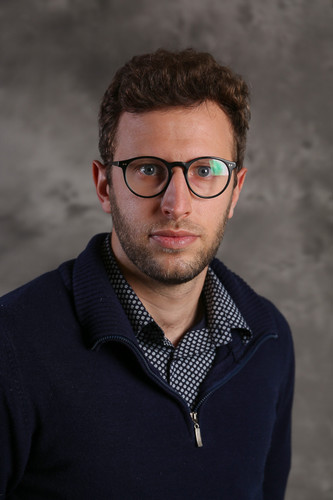Tiny but Mighty: Microneedle Patches Challenge Diabetes
 Marcos Fratus, Ph.D. student in the College of Engineering
Marcos Fratus, Ph.D. student in the College of Engineering
In distant corners of the world, two individuals found themselves united by a shared battle against diabetes. Mr. Anderson, a kind-hearted gentleman, was diagnosed with type 2 diabetes in his seventies, leading to a daily routine of discomfort and worry. Every morning, Mr. Anderson embarked on a tedious ritual. With a sharp needle, he pricked his finger, extracting a tiny droplet of blood to place on a test strip. The glucometer would display the verdict, a nerve-wracking moment amplified by the anxiety of experiencing hypoglycemia or hyperglycemia. Financial strains added to his burdens as he allocated a significant portion of his monthly budget for test strips, lancets, and tools for insulin injection.
On the other side of the world, young Emma bravely confronted type 1 diabetes with her supportive mother's help and a special glucometer that Emma turned into her superpower. Despite occasional painful finger pricks, Ms. Emma's courage shone. Her friends enjoyed candies she couldn't indulge in, making her feel different and isolated at times, especially during the last trick-or-treat Halloween adventure.
Despite their differences, Mr. Anderson and Ms. Emma shared a common dream - a future where diabetes management could be less painful and stressful, uniting them across generations and backgrounds. Then, one Monday morning, fate intervened. Mr. Anderson stumbled upon an article that filled him with excitement. Simultaneously, Ms. Emma's face lit up with a smile as an advertisement interrupted her favorite cartoon. What sparked their shared enthusiasm? Innovative microneedle (MN) patches, promising continuous glucose monitoring and on-demand insulin delivery in a minimally invasive, independent, and affordable manner! These patches introduced a closed-loop system where insulin dosage is adjusted automatically using a control algorithm and real-time glucose monitoring: No more painful finger pricks, no more anxiety, and no more dependence on expensive devices.
These MN patches have the potential to revolutionize diabetes management. Unlike conventional hypodermic needles that draw blood, they feature an array of tens to hundreds of nearly invisible, cost-effective MNs that collect and analyze skin biofluid. Their soft, hydrogel-based design sets them apart from individual stainless needles commonly found in continuous glucose monitoring (CGM) devices, replacing the need for cumbersome injectors with a gentle manual application.
However, the development of these patches comes with its challenges. Firstly, they must ensure accuracy and sensitivity exclusively to glucose while avoiding interference from other molecules, which could result in false positive readings and incorrect treatment doses. Secondly, these patches need to respond rapidly to fluctuations in skin glucose levels to enable timely corrective actions. Unlike hypodermic needles that extract blood through a syringe-based vacuum, MNs require glucose to traverse from the skin to the sensing site on the wearable patch. This journey might span minutes to hours, introducing a hurdle for continuous monitoring.
This is where my enthusiasm joins Mr. Anderson and Ms. Emma on their quest for improved diabetes management. Within my group in the Electrical and Computer Engineering (ECE) department, and in collaboration with a diverse team of experts, I utilize COMSOL-based numerical simulations and natural laws to develop a theoretical framework for MN patches. My objective is to design MN patches that achieve precise glucose detection and rapid response times. This task is pivotal since, without a theoretical basis for MN devices, developing and refining these patches depends on iterative, time-consuming, and costly experiments. Without a comprehensive theory exploring the impact of MN geometry (size and shape) and composition, achieving an MN patch that meets performance expectations would be an intricate or even impossible task.
Our results revealed the shortcomings of conventional hollow MNs, which absorb fluid across their tips through an inner channel. This design introduces significant delays, taking hundreds of minutes to produce readings, and it poses a trade-off between speed and accuracy of the result. In response, we turned our attention to porous MNs, which significantly accelerate sugar detection thanks to their increased absorbing surface. However, due to their intrinsic porosity and limited mechanical strength, these MNs would easily break during insertion into the skin.
My next objective is to enhance sugar detection by incorporating the measurement directly within the MN or by equipping the MN surface with a sensing site, thus suppressing the lag time of the analysis. Through my research, I aim to gain a comprehensive understanding of the entire closed-loop management system, presenting a holistic solution for diabetes management encompassing both sugar sensing and insulin therapy. Ultimately, both Mr. Anderson and Ms. Emma dreamed of a life free from persistent finger pricks and the anxiety of fluctuating sugar levels. The prospect of having an autonomous, miniaturized, painless tattoo-like patch to treat diabetes filled them with hope.
About the Author:
Marco Fratus is a Ph.D. candidate in the Department of Electrical and Computer Engineering. He received the B.Sc. (2014) and M.Sc. (2017) from Politecnico di Milano, Italy, in Biomedical and Electrical Engineering, respectively. He attended a Double M.Sc. degree (2015-2018) in Nanoelectronics at KTH, Stockholm, Sweden. Before joining Purdue, he was a Visiting Scholar at Columbia University, New York, USA, investigating opto-electronic properties of graphene. His current research focuses on design and optimization of wearable and implantable devices for disease diagnostics and therapy.
April 08, 2024